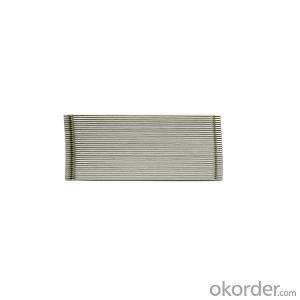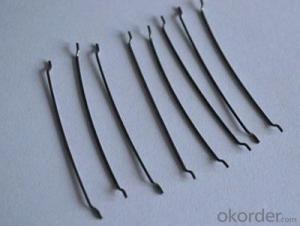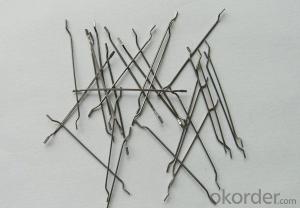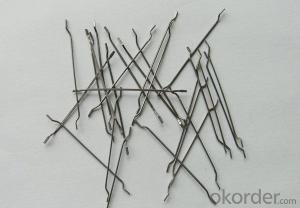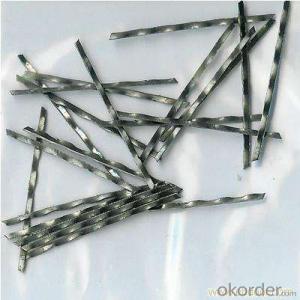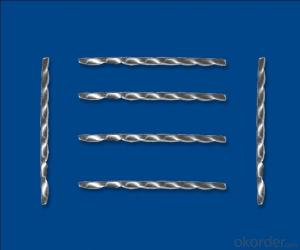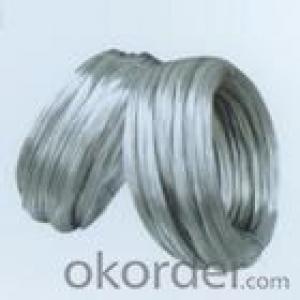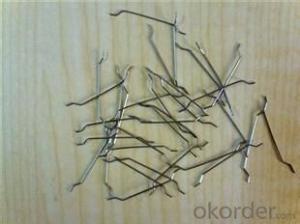Concrete steel fiber 0.75/50 from CNBM China
- Loading Port:
- Tianjin
- Payment Terms:
- TT OR LC
- Min Order Qty:
- 1 m.t.
- Supply Capability:
- 5000 m.t./month
OKorder Service Pledge
Quality Product, Order Online Tracking, Timely Delivery
OKorder Financial Service
Credit Rating, Credit Services, Credit Purchasing
You Might Also Like
Quick Details
Place of Origin: Tianjin, China (Mainland)
Model Number: 0.75
Material: Steel
Production Process: Cold drawn
Lengh: 50
Type: 1
Compressive Strength: >1200MPa
Aspect ratio: 66
Standard: ASTM A820M-11
Section Shape: Circular
Application: Concrete Reinforcement
Packaging & Delivery
| Packaging Details: | 20 kg/Bag,50 bags/Pallet or 1,000kg/ Bulk Bag |
|---|---|
| Delivery Detail: | 1 Month |
Product Description
| Diameter | 0.75 | mm | 0.03 | in |
| Length | 50.00 | mm | 1.96 | in |
| Aspect Ratio | 67 | |||
| Tensile strength | 1200 MPa | |||
| Type | Cold drawn Steel Fiber | |||
| End | Hooked-end Steel Fiber | |||
| Glued/Loose | Glued Steel Fiber | |||
| Bending Angle | 45°(min.30°) | |||
| Usage & Performance | Floor:Trafficked areas and Industrial floors | |||
| Shotcrete :Slope stabilization and Final lining | ||||
| Precast concrete:Pipe and Railway sleepers | ||||
| Packing | Standard Export Pallet Packing | Bag Packing | 20 kg/Bag,50 bags/Pallet | |
| Bulk Packing | 1,000kg/ Bulk Bag | |||
| Loading Quantity | 20’GP | 20-25 Tonne/Tonnes | ||
| 40’GP | 25-27 Tonne/Tonnes | |||
| 40’HQ | 25-27 Tonne/Tonnes | |||
| MOQ | 1 kg for trial order | |||
| Supply Ability | 10,000 Tonne/Tonnes per Year | |||
| Payment Terms | T/T or L/C at sight | |||
| Delivery Time | Within 15 days after receiving deposit or original L/C at sight | |||
| Certification | ISO9001:2000, CE, | |||
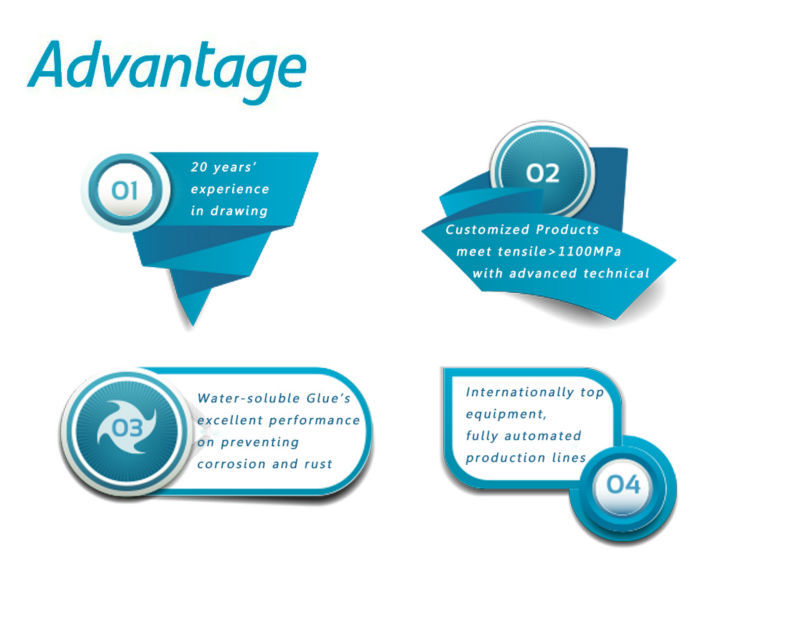
| Product | Diameter | Length mm/in | Aspect Ratio | Type | Packing |
| G-6030 | 0.5 mm (0.0197 in) | 30 mm (1.1811 in) | 60 | Glued | 20 kg/Bag, or 1,000kg/ Bulk Bag |
| G-6535 | 0.55 mm (0.0217 in) | 35 mm (1.3780 in) | 65 | Glued | 20 kg/Bag, or 1,000kg/ Bulk Bag |
| G-6035 | 0.6 mm (0.0236 in) | 35 mm (1.3780 in) | 60 | Glued | 20 kg/Bag, or 1,000kg/ Bulk Bag |
| G-8060 | 0.75 mm (0.0295 in) | 60 mm (2.3622 in) | 80 | Glued | 20 kg/Bag, 50 bags/Pallet |
| G-6060 | 0.9 mm (0.0354 in) | 60 mm (2.3622 in) | 60 | Glued | 20 kg/Bag, 50 bags/Pallet |
| G-6030 | 0.5 mm (0.0197 in) | 30 mm (1.1811 in) | 60 | Loose | 20 kg/Bag, or 1,000kg/ Bulk Bag |
| G-6535 | 0.55 mm (0.0217 in) | 35 mm (1.3780 in) | 65 | Loose | 20 kg/Bag, or 1,000kg/ Bulk Bag |
| G-6035 | 0.6 mm (0.0236 in) | 35 mm (1.3780 in) | 60 | Loose | 20 kg/Bag, or 1,000kg/ Bulk Bag |
| G-8060 | 0.75 mm (0.0295 in) | 60 mm (2.3622 in) | 80 | Loose | 20 kg/Bag, 50 bags/Pallet |
| G-6060 | 0.9 mm (0.0354 in) | 60 mm (2.3622 in) | 60 | Loose | 20 kg/Bag, 50 bags/Pallet |
- Q:Are there any limitations or precautions to consider when using melt extract stainless steel fiber?
- When using melt extract stainless steel fiber, there are certain limitations and precautions that need to be taken into account. To begin with, it should be noted that this type of fiber is not suitable for high-temperature applications. Its melting point is relatively low compared to other stainless steel alloys, meaning it may not be able to withstand extremely high temperatures without deforming or losing its structural integrity. Therefore, it is crucial to determine the maximum temperature the fiber can handle and avoid exposing it to temperatures beyond this limit. Another factor to consider is the possibility of corrosion. Although stainless steel is generally resistant to corrosion, certain environmental conditions, such as exposure to acids or chlorides, can still lead to corrosion. It is advisable to evaluate the specific corrosive agents present in the application environment and choose a stainless steel fiber grade that offers appropriate corrosion resistance. Additionally, proper handling and installation of the melt extract stainless steel fiber is important. The fibers can be sharp and pose a risk of injury if not handled correctly. It is recommended to wear gloves and other protective equipment while handling them to minimize the risk of cuts or abrasions. Furthermore, achieving the desired performance of the stainless steel fibers within a matrix material, such as concrete or composite, depends on their dispersion. It is necessary to ensure that the fibers are mixed and distributed properly to avoid clumping or agglomeration, which can result in uneven reinforcement and compromised mechanical properties. Lastly, the cost of melt extract stainless steel fiber should be taken into consideration. Compared to other options for fiber reinforcement, such as synthetic fibers or traditional steel rebars, stainless steel fiber can be more expensive. Therefore, it is important to assess the project budget and weigh the benefits of using stainless steel fiber against its higher cost. In conclusion, while melt extract stainless steel fiber offers several advantages, it is essential to be aware of its limitations and take necessary precautions. Understanding the temperature limits, potential for corrosion, handling requirements, dispersion considerations, and cost implications will help ensure the successful and safe use of this reinforcement material.
- Q:Can melt extract stainless steel fiber be used in high-temperature refractory applications?
- Indeed, high-temperature refractory applications can make use of melt extract stainless steel fiber. This fiber variant has been engineered to endure exceptionally hot temperatures and retain its structural soundness within environments characterized by intense heat. Its utilization is prevalent in refractory materials like castable refractories, ceramic fiber products, and other insulation applications pertaining to elevated temperatures. The outstanding features of melt extract stainless steel fiber encompass remarkable resistance to heat, corrosion, and mechanical stress, rendering it perfectly suitable for a diverse range of refractory applications that confront elevated temperatures.
- Q:Can melt extract stainless steel fiber be used in tunneling and underground construction?
- Yes, melt extract stainless steel fiber can be used in tunneling and underground construction. Stainless steel fibers are known for their high tensile strength, corrosion resistance, and durability, which makes them an ideal choice for reinforcement in concrete structures. In tunneling and underground construction, where the structures are subjected to high levels of stress, such as impact and vibration, the use of stainless steel fiber can enhance the structural integrity and increase the overall lifespan of the construction. Additionally, stainless steel fibers also provide improved crack resistance and fire resistance, which are crucial in underground environments. Overall, melt extract stainless steel fiber is a reliable and effective reinforcement material for tunneling and underground construction projects.
- Q:How does melt extract stainless steel fiber impact the load transfer between concrete layers?
- Melt extract stainless steel fiber has a significant impact on the load transfer between concrete layers. When added to the concrete mix, these fibers act as reinforcement, enhancing the tensile strength of the material. This reinforcement helps to distribute the load more evenly across the concrete layers, effectively transferring the applied load from one layer to another. The stainless steel fibers are uniformly dispersed within the concrete matrix, creating an interconnected network that enhances the overall structural integrity. As a result, the fibers prevent crack propagation and limit the development and widening of existing cracks between concrete layers. This behavior is crucial in load-bearing structures, as it improves the load-carrying capacity and durability of the concrete. Furthermore, the presence of melt extract stainless steel fibers helps to mitigate the effects of shrinkage and thermal stresses in concrete. These fibers reduce the likelihood of cracking caused by temperature fluctuations, as they provide reinforcement and prevent the formation of large cracks. This, in turn, enhances load transfer between layers by maintaining the structural integrity of the concrete. In summary, the addition of melt extract stainless steel fibers in concrete significantly improves the load transfer between layers. These fibers reinforce the concrete matrix, distribute the applied load more evenly, prevent crack propagation, and mitigate shrinkage and thermal stresses. Ultimately, this results in a stronger, more durable concrete structure with enhanced load-carrying capacity and longevity.
- Q:Can melt extract stainless steel fiber be used in bridge deck overlays for asphalt mixtures?
- Bridge deck overlays for asphalt mixtures can indeed utilize melt extract stainless steel fiber. By incorporating these fibers, the overall performance and durability of the asphalt mixtures are enhanced. The introduction of stainless steel fibers aids in the improvement of tensile strength, crack resistance, and fatigue resistance for the asphalt overlay. This is especially advantageous for bridge deck overlays due to the heavy traffic loads, temperature fluctuations, and exposure to various environmental conditions they encounter. Moreover, the stainless steel fibers provide reinforcement, preventing the formation and spread of cracks, ultimately extending the service life of the bridge deck. Furthermore, the corrosion-resistant nature of stainless steel renders it a fitting choice for bridge deck overlays, where exposure to moisture and deicing salts is commonplace. In summary, the incorporation of melt extract stainless steel fibers in bridge deck overlays for asphalt mixtures presents a feasible solution to enhance the performance and durability of the overlay system.
- Q:What is the effect of melt extract stainless steel fiber on the flexural strength of concrete?
- The use of melt extract stainless steel fiber in concrete can have a significant effect on its flexural strength. Stainless steel fibers are added to concrete mixes to increase its tensile strength and enhance its resistance to cracking and structural failure under bending or flexural stress. When properly dispersed and distributed within the concrete matrix, stainless steel fibers act as reinforcement, providing additional strength and ductility to the material. As a result, the incorporation of these fibers improves the flexural strength of concrete, allowing it to withstand greater loads and resist deformation or failure when subjected to bending forces. The unique properties of stainless steel, such as high tensile strength, corrosion resistance, and thermal stability, make it an ideal choice for enhancing the flexural strength of concrete. The fibers effectively bridge micro-cracks that may form during the curing and drying process, preventing their propagation and reducing the risk of structural damage. The presence of melt extract stainless steel fibers in concrete also improves its overall durability and longevity, as it minimizes the formation of cracks due to shrinkage, thermal expansion, or external factors. This enhanced resistance to cracking not only enhances the flexural strength but also helps maintain the structural integrity of the concrete over time. Furthermore, the addition of stainless steel fibers can provide additional benefits such as improved impact resistance, reduced permeability, and enhanced resistance to chemical attack, which further contribute to the overall performance and durability of the concrete. In conclusion, the effect of melt extract stainless steel fiber on the flexural strength of concrete is positive and significant. The incorporation of these fibers enhances the tensile strength, crack resistance, and overall durability of the concrete, allowing it to withstand greater bending forces and maintain its structural integrity over time.
- Q:What is the effect of melt extract stainless steel fiber on the crack resistance of concrete?
- The effect of melt extract stainless steel fiber on the crack resistance of concrete is that it significantly improves the overall crack resistance. The addition of these fibers helps to distribute the stress throughout the concrete, reducing the formation and propagation of cracks. This leads to increased durability and longevity of the concrete structure.
- Q:Does melt extract stainless steel fiber enhance the impact resistance of concrete slabs?
- Yes, melt extract stainless steel fiber does enhance the impact resistance of concrete slabs.
- Q:How does melt extract stainless steel fiber improve the resistance to corrosion in concrete?
- The resistance to corrosion in concrete is enhanced by melt extract stainless steel fiber through various mechanisms. Firstly, the stainless steel fibers function as a physical barrier, preventing the penetration of harmful substances such as chlorides and sulfates into the concrete and reaching the reinforcing steel. This barrier effect reduces the exposure of the steel to corrosive agents, minimizing the risk of corrosion. Secondly, stainless steel possesses inherent corrosion resistance due to its high chromium content. This alloying element creates a passive oxide layer on the steel's surface, which acts as a protective barrier against corrosion. When stainless steel fibers are added to concrete, this passive oxide layer helps shield the embedded steel from corrosive attacks, improving the overall durability and lifespan of the concrete structure. Moreover, incorporating melt extract stainless steel fibers enhances the mechanical properties of concrete, making it more resistant to cracking and shrinkage. By reducing crack occurrence and minimizing concrete permeability, the ingress of corrosive agents is significantly decreased, thereby enhancing the concrete's corrosion resistance. Additionally, the high tensile strength and ductility of stainless steel fibers provide an extra layer of reinforcement within the concrete matrix. This reinforcement ensures a more even distribution of stress throughout the structure, preventing localized weak areas that could initiate corrosion. To summarize, melt extract stainless steel fiber improves the corrosion resistance in concrete by acting as a physical barrier, providing inherent corrosion resistance, enhancing concrete's mechanical properties, and offering additional reinforcement. These combined effects contribute to the long-term durability and corrosion resistance of concrete structures in various environments.
- Q:What are the environmental benefits of using melt extract stainless steel fiber in concrete?
- Using melt extract stainless steel fiber in concrete presents various environmental advantages. To begin with, stainless steel is an incredibly durable material renowned for its long lifespan. By incorporating stainless steel fibers into concrete, the overall durability and lifespan of the concrete structure are enhanced. Consequently, less concrete will need to be manufactured and replaced over time, resulting in decreased resource consumption and waste generation. Furthermore, the utilization of stainless steel fibers can bolster the structural integrity of concrete, allowing for reduced thickness and weight of concrete structures. Consequently, the amount of concrete required for construction projects is diminished, resulting in lower carbon emissions associated with concrete production. Additionally, stainless steel fibers can improve the crack resistance and impact resistance of concrete, minimizing the necessity for frequent repairs or replacements. As a result, maintenance and repair activities are reduced, leading to lower energy consumption and waste generation related to concrete upkeep. Moreover, the incorporation of stainless steel fibers in concrete can enhance its resistance to corrosion and chemical attack, thereby increasing its lifespan in harsh environments. This decreases the need for premature demolition and reconstruction, resulting in less waste generation and resource consumption. Lastly, stainless steel is a recyclable material that can be reused after reaching the end of its useful life. This means that the stainless steel fibers used in concrete can be recovered and recycled, reducing the demand for new stainless steel production and minimizing the environmental impact associated with its extraction and manufacturing processes. In conclusion, the use of melt extract stainless steel fiber in concrete offers numerous environmental benefits, including reduced resource consumption, lower carbon emissions, decreased waste generation, and increased recyclability.
1. Manufacturer Overview |
|
|---|---|
| Location | |
| Year Established | |
| Annual Output Value | |
| Main Markets | |
| Company Certifications | |
2. Manufacturer Certificates |
|
|---|---|
| a) Certification Name | |
| Range | |
| Reference | |
| Validity Period | |
3. Manufacturer Capability |
|
|---|---|
| a)Trade Capacity | |
| Nearest Port | |
| Export Percentage | |
| No.of Employees in Trade Department | |
| Language Spoken: | |
| b)Factory Information | |
| Factory Size: | |
| No. of Production Lines | |
| Contract Manufacturing | |
| Product Price Range | |
Send your message to us
Concrete steel fiber 0.75/50 from CNBM China
- Loading Port:
- Tianjin
- Payment Terms:
- TT OR LC
- Min Order Qty:
- 1 m.t.
- Supply Capability:
- 5000 m.t./month
OKorder Service Pledge
Quality Product, Order Online Tracking, Timely Delivery
OKorder Financial Service
Credit Rating, Credit Services, Credit Purchasing
Similar products
New products
Hot products
Hot Searches
Related keywords
